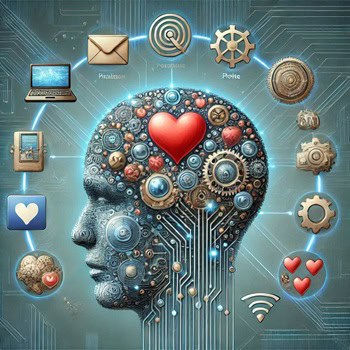Beyond Technology: How Emotional Intelligence Drives Digital Service Success
- Catherine Manin
- Feb 3
- 7 min read
In today’s digital-first world, we often focus on technology to improve response times, automation, and self-service options when designing and delivering digital customer service.
However, the true differentiator between good and exceptional service lies in something more fundamental: Emotional Intelligence (EI).
Emotional Intelligence is the ability to recognize, understand, and manage your own emotions while interpreting and responding to the emotions of others.
While technology enhances efficiency, EI allows you to understand, respond to, and connect with users in a meaningful way.
In digital customer service, this skill is crucial for building strong connections, especially since non-verbal cues are absent.
In this post, I’ll explore how Emotional Intelligence plays a key role in overcoming the challenges of digital customer service and how you can integrate it into your approach for more impactful results.

Emotional Intelligence in Digital Customer Service
The Human Element in Digital Interactions
Despite the absence of face-to-face contact, digital services are still fundamentally human experiences.
Every digital interaction is shaped by the emotions, expectations, and concerns of the user. Whether a customer struggles with an online banking app or feels confused by a technical support portal, their emotional response—frustration, anxiety, or confusion—is just as real as in any physical interaction.
In today’s digital-first world, where communication often happens through text-based channels like email, live chat, or social media, these emotional cues can be easily overlooked. Without tone, body language, or facial expressions, it’s harder to interpret emotions like frustration or confusion.
However, these emotions still play a crucial role in shaping the user experience.
If not addressed, the user may feel unheard or undervalued, damaging satisfaction and loyalty.
This is where Emotional Intelligence becomes vital. It allows you to go beyond resolving technical issues and connect with customers on an emotional level.
Recognizing when a customer is frustrated or confused—even without explicit emotional cues—can enable you to offer empathy, validation, and personalized support, transforming the experience from transactional to meaningful.
Let’s now take a look at how prioritizing EI can make a difference.

Why Emotional Intelligence is Essential in Digital Customer Service
Focusing on Emotional Intelligence in digital customer service can result in the following measurable benefits for both your customers and service teams:
Enhancing Customer Experience
By recognizing emotional cues, agents can respond with empathy and understanding, adapting their tone, language, and approach to address customer concerns in a way that feels genuine. This personalized approach turns routine interactions into moments of connection and satisfaction.
Resolving Conflicts Effectively
Emotionally intelligent teams validate frustrations and provide thoughtful solutions, resolving issues quickly while building trust and preventing minor issues from escalating. This addresses immediate concerns and minimizes future conflicts, saving time and resources.
Strengthening Brand Loyalty
When customers feel valued, they’re more likely to stay loyal and recommend the brand, driving repeat business and referrals. Emotional connections foster loyalty that distinguishes a brand in competitive markets.
Boosting Team Morale
Emotional intelligence training equips agents to handle high-pressure situations while managing their emotions effectively. They can stay calm under stress, maintain professionalism, and consistently deliver high-quality service—reducing burnout and increasing job satisfaction.

Key Components of Emotional Intelligence
To effectively apply Emotional Intelligence in digital customer service, it’s essential to understand its core components.
Each of them contributes to creating meaningful interactions, even in the absence of non-verbal communication.
Here’s a deeper look at these components with examples:
Self-Awareness
It's the ability to recognize and understand your own emotions and how they influence your actions and interactions.
What happens when you let frustration affect your interactions?
After dealing with several difficult cases, you may feel frustrated.
Instead of allowing that emotion to spill into your next customer interaction, you take a moment to acknowledge how you're feeling, which helps you refocus and approach the next interaction with clarity and calmness.
Self-Regulation
It involves managing your emotions so you can respond calmly and appropriately, even under pressure.
What if you react impulsively to an angry customer?
When a customer sends an angry email, it’s easy to respond defensively.
However, by practicing self-regulation, you take a deep breath, pause, and then craft a professional, empathetic response.
This approach prevents negative emotions from affecting your behavior, helping you address the issue thoughtfully and professionally.
Empathy
Its the ability to understand and share the feelings of others, which helps build meaningful connections.
What if you overlook a customer's feelings?
When a customer expresses frustration about a delayed order, ignoring their emotions could escalate the situation.
Instead, by acknowledging their feelings with empathy, such as saying, “I understand how this delay has been frustrating for you,” you validate their experience and help guide the interaction toward a more positive resolution.
Social Skills
Involve effectively navigating interactions and building rapport with others, even in challenging situations.
What happens if your interactions feel robotic or distant?
During a live chat, if you don’t personalize your responses, customers may feel unimportant.
By using strong social skills—addressing the customer by name, maintaining a friendly tone, and offering clear, helpful answers—you create a positive and professional interaction that makes the customer feel valued and respected.

EI in Action: Transforming Digital Customer Interactions
Building on the core components of Emotional Intelligence, here’s how to apply these principles effectively in digital customer service:
Empathy in Written Communication
Empathy is critical in overcoming the emotional distance of digital interactions. Personalization, validation, and maintaining a warm tone are key to showing genuine care.
How to Apply:
Personalize responses by addressing customers by name and referencing their specific concerns.
Validate emotions with phrases like “I understand how this can be frustrating” to acknowledge their feelings.
Use a warm tone, even in text, by choosing friendly and encouraging language, such as “I’d be happy to assist.”
Example:
Instead of saying, “Your request is being processed,” a more empathetic response might be: “Thank you for bringing this to our attention, . I completely understand how important this is to you, and I’m here to help resolve it as quickly as possible.”
Active Listening
Even in text-based interactions, demonstrating active listening helps customers feel heard and valued.
How to Apply:
Paraphrase concerns: Summarize the customer’s issue to confirm your understanding.
Use the customer’s name in replies to make the interaction more personal.
Respond promptly to show attentiveness and engagement.
Example:
Customer: “I’ve emailed twice about my order, and I’m getting no updates!” Response: “I see that you’ve reached out earlier, , and I sincerely apologize for the delay. Let me check your order details and provide an update right away.”
Tone Management
A tailored tone conveys understanding and professionalism, even in emotionally charged situations.
How to Apply:
Recognize the customer’s emotional state (e.g., frustration, urgency) and adapt your tone accordingly.
Use positive phrasing to maintain a constructive interaction. For example, replace “We can’t do that” with “Here’s what I can offer to help.”
Balance professionalism with warmth to keep communication respectful yet approachable.
Example:
Customer: “I’m really upset that my refund is taking so long!” Response: “I completely understand how frustrating this must be, . I’m currently looking into your refund and will make sure it’s processed as quickly as possible. I’ll keep you updated every step of the way.”
Problem Resolution with Emotional Awareness
Resolving customer issues requires addressing both the technical problem and the emotional impact.
How to Apply:
Offer clear, step-by-step solutions while acknowledging the inconvenience caused.
Follow up to ensure both the issue and the customer’s concerns are fully resolved.
Express genuine commitment, such as “I’ll personally make sure this is resolved for you.”
Example:
A customer upset about a billing error could receive a response like: “I completely understand how this situation has been frustrating, . I’ve reviewed your account and corrected the error. You’ll see the adjustment reflected immediately. Please let me know if there’s anything else I can assist you with.”
Reading Between the Lines
Understanding subtle emotional cues in written communication helps in responding appropriately.
How to Apply:
Identify urgency through word choice or punctuation (e.g., “I need this fixed ASAP!”).
Recognize frustration in message formatting (e.g., all caps or repeated exclamation points).
Adjust your response based on the implied emotional state, ensuring it addresses both the concern and the underlying emotion.
Example:
Customer: “I’ve been waiting for TWO WEEKS!!!” Response: “I sincerely apologize for the delay, . I can see how this has been a frustrating experience. Let me resolve this for you right away.”

The Future of Emotional Intelligence in Customer Service
As technology continues to advance, Emotional Intelligence will become more seamlessly integrated with digital tools, revolutionizing the way customer service operates. Sentiment analysis—an AI-powered tool that interprets the emotions behind customer interactions—will allow you to gather emotional insights and prioritize emotional cues, even in text-based communication.
How AI and Emotional Intelligence Work Together
While AI can suggest empathetic responses or flag urgent issues, human oversight remains crucial to ensure responses are authentic and empathetic. Customized templates for common emotional scenarios will help manage sensitive interactions, providing a personal touch to standard responses.
Emotion AI in Action
Emotion AI tools can identify and analyze customer emotions in real-time, helping you respond with greater empathy. While AI can handle routine tasks like answering general inquiries, your focus will shift to more complex, emotionally charged interactions—creating a more personalized customer experience.
Looking Ahead
The future of customer service will rely on a synergy between AI’s efficiency and human empathy.
Advancements like virtual reality (VR) could play a key role in Emotional Intelligence training, providing immersive scenarios to practice managing emotionally intense interactions in a realistic, controlled environment.
AI-driven feedback systems will further support agents in refining their Emotional Intelligence skills.
As emotion recognition technology continues to evolve, ethical considerations regarding its use will become increasingly important, ensuring that emotional insights are handled responsibly.

Conclusion
In today’s digital world, Emotional Intelligence isn’t just important—it’s a must-have.
By understanding and managing emotions—both your own and your customers’—you can create meaningful connections that build trust and loyalty.
As technology continues to evolve, finding the right balance between efficiency and Emotional Intelligence will be key to delivering outstanding digital experiences.
Emotional Intelligence is the driving force behind creating genuine connections, even in a digital landscape.
Remember: Technology brings us together, but Emotional Intelligence keeps us connected!

Prefer a video format?
Watch it here or on my YouTube channel: @empowiredva!


Comments